Seventeen Provinces
| Seventeen Provinces | ||||||||||||
| Personal union of Imperial fiefs | ||||||||||||
| ||||||||||||
| ||||||||||||
 Map of the Seventeen Provinces, 1581 secession outlined in red | ||||||||||||
| Capital | Brussels | |||||||||||
| Languages | Dutch, Low Saxon, Frisian, Walloon, Luxembourgish, French | |||||||||||
| Religion | Roman Catholic Protestant | |||||||||||
| Government | Monarchy | |||||||||||
| Historical era | Early modern period | |||||||||||
| • | Pragmatic Sanction of 1549 | 1549 | ||||||||||
| • | Dutch Act of Abjuration | 1581 | ||||||||||
| ||||||||||||
The Seventeen Provinces was a term applied to the Imperial states of the Habsburg Netherlands in the 15th and 16th century. They roughly covered the Low Countries, i.e. the current Netherlands, Belgium, and Luxembourg, plus most of the modern French department of Nord including Artois, French Flanders, and French Hainaut. Also enclosed in this area were semi-independent fiefdoms, mainly ecclesiastical ones, such as Liège, Cambrai and Stavelot-Malmedy.
The Seventeen Provinces arose from the Burgundian Netherlands, a number of fiefs held by the House of Valois-Burgundy and inherited by the Habsburg dynasty in 1482, from 1556 held by Habsburg Spain. Since 1512 the Provinces formed the major part of the Burgundian Circle. In 1581 the Seven United Provinces seceded to form the Dutch Republic.
Composition
After the Habsburg emperor Charles V had re-acquired the Duchy of Guelders from Duke William of Jülich-Cleves-Berg by the 1543 Treaty of Venlo, the Seventeen Provinces comprised:
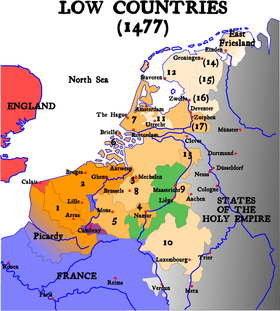
- the County of Artois
- the County of Flanders, including the burgraviates of Lille, Douai, Orchies, the Lordship of Tournai and the Tournaisis
- the Lordship of Mechelen
- the County of Namur
- the County of Hainaut
- the County of Zeeland
- the County of Holland
- the Duchy of Brabant, including the Lordship of Breda, the Margraviate of Antwerp, the counties of Leuven and of Brussels, and the advocacy of the Abbey of Nivelles and of Gembloux
- the Duchy of Limburg and the "Overmaas" lands of Brabant (Dalhem, Valkenburg and Herzogenrath)
- the Duchy of Luxembourg
- the Prince-Bishopric, later Lordship of Utrecht
- the Lordship of Frisia
- the Duchy of Guelders
- the Lordship of Groningen (including the Ommelanden)
- the Lordship of Drenthe, Lingen, Wedde, and Westerwolde
- the Lordship of Overijssel
- the County of Zutphen
It was not always the same Seventeen Provinces represented at the Estates-General of the Netherlands. Sometimes one delegation was included in another.
In later years the County of Zutphen became a part of the Duchy of Guelders, and the Duchy of Limburg was dependent on the Duchy of Brabant. The Lordship of Drenthe is sometimes considered as part of the Lordship of Overijssel. On the other hand, the French-speaking cities of Flanders were sometimes recognised as a separate province.
Therefore, in some lists Zutphen and Drenthe are replaced by
- burgraviates of Lille, Douai, Orchies (also called Lilloise Flanders)
- Tournai and the Tournaisis
There were a number of fiefdoms in the Low Countries that were not part of the Seventeen Provinces, mainly because they did not belong to the Burgundian Circle but to the Lower Rhenish-Westphalian Circle. The largest of these was the Prince-Bishopric of Liège, the green area on the map, including the County of Horne. The ethnically and culturally Netherlandish duchies of Cleves and Julich did not join either. In the north, there were also a few smaller entities like the island of Ameland that would retain their own lords until the French Revolution.
Historians came up with different variations of the list, but always with 17 members. This number could have been chosen because of its Christian connotation.[1][2]
History
The Seventeen Provinces originated from the Burgundian Netherlands. The dukes of Burgundy systematically became the lord of different provinces. Mary I of Valois, Duchess of Burgundy was the last of the House of Burgundy.
Mary married Maximilian I of Habsburg, Emperor of the Holy Roman Empire in 1477, and the provinces were acquired by the House of Habsburg on her death in 1482, with the exception of the Duchy of Burgundy itself, which, with an appeal to Salic law, had been reabsorbed into France upon the death of Mary's father, Charles the Bold. Maximilian's grandson, Charles V of Habsburg, Emperor of the Holy Roman Empire and King of Spain, eventually united all seventeen provinces under his rule, the last one being the Duchy of Guelders, in 1543.
Most of these provinces were fiefs of the Holy Roman Empire. Two provinces, the County of Flanders and County of Artois, were originally French fiefs, but sovereignty was ceded to the Empire in the Treaty of Cambrai in 1529.
The Pragmatic Sanction of 1549 determined that the Provinces should remain united in the future and inherited by the same monarch. Therefore, Charles V introduced the title of Heer der Nederlanden ("Lord of the Netherlands"). Only he and his son could ever use this title.
After Charles V's abdication in 1555, his realms were divided between his son, Philip II of Habsburg, King of Spain, and his brother, Ferdinand I, Holy Roman Emperor. The Seventeen Provinces went to his son, the king of Spain.
Conflicts between Philip II and his Dutch subjects led to the Eighty Years' War, which started in 1568. The seven northern provinces gained their independence as a republic called the Seven United Provinces. They were:
- the Lordship of Groningen and of the Ommelanden
- the Lordship of Friesland
- the Lordship of Overijssel
- the Duchy of Guelders (except its upper quarter) and the County of Zutphen
- the Prince-Bishopric, later Lordship of Utrecht
- the County of Holland
- the County of Zeeland
The southern provinces, Flanders, Brabant, Namur, Hainaut, Luxembourg and the others, were restored to Spanish rule due to the military and political talent of the Duke of Parma, especially at the Siege of Antwerp (1584–1585). Hence, these provinces became known as the Spanish Netherlands or Southern Netherlands.
The northern Seven United Provinces kept parts of Limburg, Brabant, and Flanders during the Eighty Years' War (see Generality Lands), which ended with the Treaty of Westphalia in 1648.
Artois and parts of Flanders and Hainaut (French Flanders and French Hainaut) were ceded to France in the course of the 17th and 18th century.
Economy
By the mid-16th century, the Margraviate of Antwerp (Duchy of Brabant) had become the economic, political, and cultural center of the Netherlands after its capital had shifted from the nearby Lordship of Mechelen to the city of Brussels.
Bruges (County of Flanders) had already lost its prominent position as economic powerhouse of northern Europe. And Holland was gradually gaining importance in the 15th and 16th centuries.
However, after the revolt of the seven northern provinces (1568), the Sack of Antwerp (1576), the Fall of Antwerp (1584-1585), and the resulting closure of the Scheldt river to navigation, a large number of people from the southern provinces emigrated north to the new republic. The center of prosperity moved from cities in the south such as Bruges, Antwerp, Ghent, and Brussels to cities in the north, mostly Holland, including Amsterdam, The Hague, and Rotterdam.
Netherlands

To distinguish between the older and larger Low Countries of the Netherlands from the current country of the Netherlands, Dutch speakers usually drop the plural for the latter. They speak of Nederland in singular for the current country and of de Nederlanden in plural for the integral domains of Charles V.
In other languages, this has not been adopted, though the larger area is sometimes known as the Low Countries in English.
The fact that the term Netherlands has such different historical meanings can sometimes lead to difficulties in expressing oneself correctly. For example, composers from the 16th century are often said to belong to the Dutch School (Nederlandse School). Although they themselves would not have objected to that term at that time, today it may wrongly create the impression that they were from the current Netherlands. In fact, they were almost exclusively from current Belgium.
Flanders
The same confusion exists around the word Flanders. Historically, it applied to the County of Flanders, corresponding roughly with the present day provinces of West Flanders and East Flanders. But when the Dutch-speaking population of Belgium sought more rights in the 19th century, the word Flanders was reused, but now to indicate the Dutch-speaking part of Belgium, of which the county of Flanders was just partly a part of (see Flemish Movement).
So the territory of the County of Flanders and present-day Flanders do not fully match:
- French Flanders belonged to the County of Flanders, but is today part of France.
- Zeelandic Flanders belonged to the County of Flanders, but is today part of the Netherlands.
- Tournai and the Tournaisis was some period considered as part of the County of Flanders, but is today part of Wallonia.
- The present-day Belgian province of Flemish Brabant belongs to present-day Flanders, but was part of the Duchy of Brabant.
- The present-day Belgian province of Antwerp belongs to present-day Flanders, but was part of the Duchy of Brabant.
- The present-day Belgian province of Limburg belongs to present-day Flanders, but was part of the Prince-Bishopric of Liège.
This explains for instance why the province of East Flanders is not situated in the east of present-day Flanders.
Coats of arms
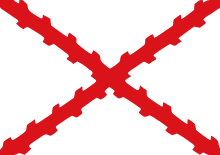 Seventeen Provinces
Seventeen Provinces

 II. Duchy of Brabant
II. Duchy of Brabant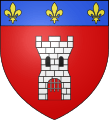 III. Bishopric of Tournai
III. Bishopric of Tournai
.svg.png)
 VI. Lordship of Groningen and of the Ommelanden
VI. Lordship of Groningen and of the Ommelanden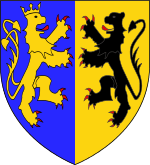 VII. Duchy of Guelders
VII. Duchy of Guelders VIII. County of Hainaut
VIII. County of Hainaut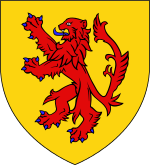
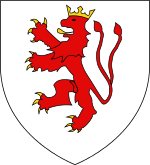

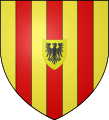 XII. Lordship of Mechelen
XII. Lordship of Mechelen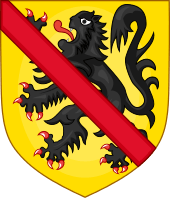 XIII. County of Namur
XIII. County of Namur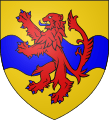
 XV. Prince-Bishopric, later Lordship of Utrecht
XV. Prince-Bishopric, later Lordship of Utrecht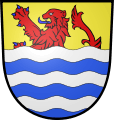 XVI. County of Zeeland
XVI. County of Zeeland XVII. County of Zutphen
XVII. County of Zutphen
See also
- Governors of the Habsburg Netherlands
- The Netherlands (disambiguation)
- Burgundian Netherlands
- Greater Netherlands
- French Flemish
- Benelux
- Armorial of the leading Netherlands Nobles (in French)
Notes and references
- ↑ http://www.leidenuniv.nl/en/researcharchive/index.php3-c=297.htm The Invention of the Dutchman: the Dynamics of Identity in the Low Countries, 1400-1600; international colloquium, 2007 Leiden University
- ↑ http://toastmastersd17.org/files/Properties-of-the-number-17.pdf
External links
| Wikimedia Commons has media related to Seventeen Provinces. |


